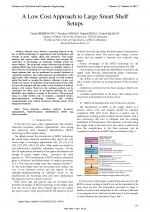| 4/2011 - 19 | View TOC | « Previous Article | Next Article » |
A Low Cost Approach to Large Smart Shelf SetupsHREBENCIUC, F. |
| Extra paper information in |
| Click to see author's profile in |
| Download PDF |
Author keywords
antenna radiation pattern, inventory management, radiofrequency identification, RFID tag, microcontroller
References keywords
rfid(41), antenna(16), antennas(11), smart(10), systems(9), frequency(9), technology(8), loop(8), propagation(7), high(7)
Blue keywords are present in both the references section and the paper title.
About this article
Date of Publication: 2011-11-30
Volume 11, Issue 4, Year 2011, On page(s): 117 - 122
ISSN: 1582-7445, e-ISSN: 1844-7600
Digital Object Identifier: 10.4316/AECE.2011.04019
Web of Science Accession Number: 000297764500019
SCOPUS ID: 84856609401
Abstract
Recent years showed a growing interest in the use of RFID technology in applications like distribution and storage of goods, supply chain and inventory. This paper analyses the current smart shelf solutions and presents the experience of developing an automatic reading system for smart shelves. The proposed system addresses the problem of reading RFID tags from items placed on multiple shelves. It allows the use of standard low cost readers and tags and uses a single antenna that can be positioned in specific locations at repeatable positions. The system proposes an alternative to the approaches with multiple antennas placed in fixed position inside the shelf or around the shelves, offering a lower cost solution by means of dedicated electromechanical devices able to carry the antenna and the reader to the locations of interest along a rail system. Moreover, antenna position can be controlled for three axis of movement allowing for extra flexibility and complete coverage of the shelves. The proposed setup is a fully wireless one. It contains a standard reader, electromechanical positioning actuators and wireless communication and control hardware offering power from integrated batteries. |
| References | | | Cited By |
Web of Science® Times Cited: 2 [View]
View record in Web of Science® [View]
View Related Records® [View]
Updated 2 weeks, 4 days ago
SCOPUS® Times Cited: 3
View record in SCOPUS® [Free preview]
View citations in SCOPUS® [Free preview]
[1] Circuit Theory Analysis of Aperture Coupled Patch Antenna for Wireless Communication, Singh, Ashish, Aneesh, Mohammad, Kamakshi, Kumari, Ansari, J. A., Radioelectronics and Communications Systems, ISSN 0735-2727, Issue 4, Volume 61, 2018.
Digital Object Identifier: 10.3103/S0735272718040040 [CrossRef]
[2] The design and implementation of a GSM based user-machine interacted refrigerator, Guruler, Huseyin, 2015 International Symposium on Innovations in Intelligent SysTems and Applications (INISTA), ISBN 978-1-4673-7751-5, 2015.
Digital Object Identifier: 10.1109/INISTA.2015.7276719 [CrossRef]
[3] A mathematical approach of a HF RFID multi loop antenna for metallic environments, Finis, I., Popa, V., Lavric, A., 2012 International Conference and Exposition on Electrical and Power Engineering, ISBN 978-1-4673-1172-4, 2012.
Digital Object Identifier: 10.1109/ICEPE.2012.6463854 [CrossRef]
Disclaimer: All information displayed above was retrieved by using remote connections to respective databases. For the best user experience, we update all data by using background processes, and use caches in order to reduce the load on the servers we retrieve the information from. As we have no control on the availability of the database servers and sometimes the Internet connectivity may be affected, we do not guarantee the information is correct or complete. For the most accurate data, please always consult the database sites directly. Some external links require authentication or an institutional subscription.
Web of Science® is a registered trademark of Clarivate Analytics, Scopus® is a registered trademark of Elsevier B.V., other product names, company names, brand names, trademarks and logos are the property of their respective owners.
Faculty of Electrical Engineering and Computer Science
Stefan cel Mare University of Suceava, Romania
All rights reserved: Advances in Electrical and Computer Engineering is a registered trademark of the Stefan cel Mare University of Suceava. No part of this publication may be reproduced, stored in a retrieval system, photocopied, recorded or archived, without the written permission from the Editor. When authors submit their papers for publication, they agree that the copyright for their article be transferred to the Faculty of Electrical Engineering and Computer Science, Stefan cel Mare University of Suceava, Romania, if and only if the articles are accepted for publication. The copyright covers the exclusive rights to reproduce and distribute the article, including reprints and translations.
Permission for other use: The copyright owner's consent does not extend to copying for general distribution, for promotion, for creating new works, or for resale. Specific written permission must be obtained from the Editor for such copying. Direct linking to files hosted on this website is strictly prohibited.
Disclaimer: Whilst every effort is made by the publishers and editorial board to see that no inaccurate or misleading data, opinions or statements appear in this journal, they wish to make it clear that all information and opinions formulated in the articles, as well as linguistic accuracy, are the sole responsibility of the author.



